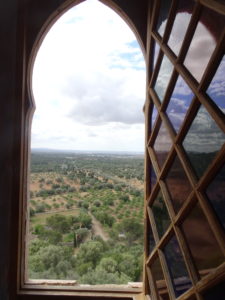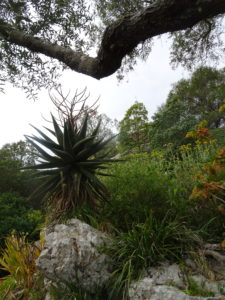Discovering the Gardens of Mallorca
I recently had the opportunity to visit a wide variety of gardens on the island of Mallorca. It was a two-centre holiday with two nights in the capital Palma and the rest of the week in the lovely resort of Port de Soller on the mountainous north side of the island. The terrain on the island is challenging and there is just one central motorway; on one occasion we had to travel in two smaller minibuses to negotiate the winding, steep road to Finca d’Ariant, but it was well worth it for the spectacular views and a tour of the Mediterranean garden with the gardener, followed by a typical Mallorcan picnic.
The historic gardens of Mallorca range from small courtyards to the large, grand gardens of agricultural estates. Their character is influenced by several main factors – climate, topography, history, owners’ beliefs and background and wealth. The Mediterranean climate allows a wide range of plants, including subtropical ones, to be grown. The topography of the island, with an extensive mountain range, the Serra de Tramuntana (a UNESCO World Heritage Site), along the north coast and plains and a smaller range of hills to the south, raises the possibility of dramatically sited and landscaped gardens. Most of the large-scale important historic gardens are sited in the mountains and foothills of the Serra de Tramuntana to the north and north-east of Palma.
The most enduring garden-making phase came with the conquest of the island by the Moors, who arrived from what is today Morocco, in 902 AD. The island, with its fertile plains, benign climate and abundant water in the hills, must have seemed like their vision of paradise. The Moors brought with them agricultural skills and innovations that are still visible in the landscape today, most notably their water engineering and the construction of numerous hill terraces which dominate the landscape of the island.
We visited several important sites where evidence of Moorish gardens survive, notably Raixa and Alfabia. At the former the eight terraces (the number is highly symbolic in Muslim culture) which formed a pre-1229 Moorish garden ascend the rocky hillside. Next to the walls the water channels (alfagra) survive, which are fed by a complex system of aqueducts from a nearby spring and a later C18 reservoir. The gardens at Alfabia are about 800 years old and are the most important and best preserved on Mallorca. They are laid out as a paradise or Jannah Garden where the righteous live after death. The two main areas are segregated, the main one for men and an enclosed private harem garden for women which includes a stone vaulted swimming pool with views out to the surrounding mountains. The garden also includes a stone pergola with water jets, a fun way to cool off; these possibly also date from the Moorish period as there are similar jets at the Generalife in Granada.
Another highlight of the trip was a visit to Sa Torre Cega designed by Russell Page in the 1960s. Page was inspired by the Moorish gardens of Spain and the project kept him busy for 15 years, making a collection of gardens connected by step paths. The pergola was copied from the one at Alfabia. We were fortunate to visit this garden as it had only recently been restored following the pandemic, and we were the first group to have a guided tour.
Other highlights were a visit to two botanical gardens: Botanicatus, a succulent garden at Ses Salines and Soller Botanic Gardens. The last two days of the trip were spent in and around Port de Soller where they were preparing for the fiesta of the Feria and Firó, celebrating the victory of the ‘Sollerics’ against Saracens who invaded on 11 of May 1561. Firecrackers could be heard going off across the town; fortunately we had to leave for the airport before the invasion took place.
Claire de Carle
The trip was organised by Robert Peel for Alumni of the Architectural Association and their guests. The guides on were Liz Whittle and Tim Bayliss Smith
References: Liz Whittle – Notes for the AAA trip – Historic Gardens of Mallorca








